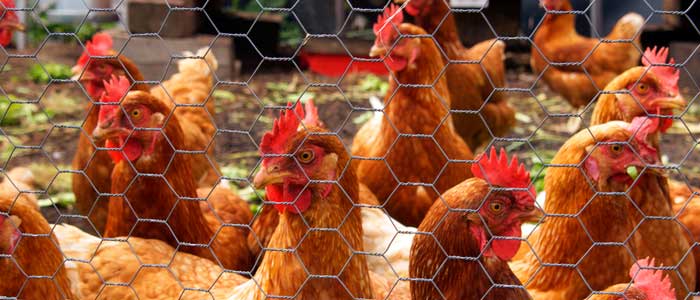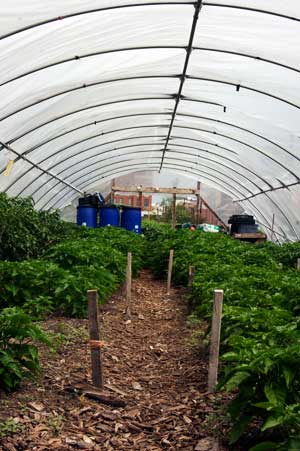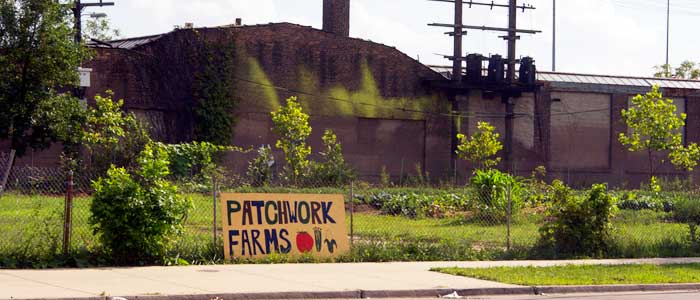There’s something growing in the vacant lots of Chicago, pockets of green that fill the empty spaces in the city. Wide leaves of squash spread out across the ground. Pale tendrils curl around chain link fences, pulling themselves toward the sky. On a street littered with 4am bars, taquerias and car washes, corn stalks bob in the breeze of passing cars, their leaves a gaudy green in the sunlight.
Urban agriculture is a growing movement in cities across America, particularly ones where the recession and the slow death of the manufacturing sector has left large swaths of industrial land empty of purpose. In these cities, poverty, environment and geography can all restrict one’s access to fresh food. Mayor Emanuel has been courting supermarket chains in an effort to bring fresh oases to what politicians and urban planners call “food deserts,” but others are taking matters it into their own hands, trying to grow a different solution.
Cities and agriculture are inextricably intertwined. In After the Ice: A Global Human History, author Steven Mithen discusses the advent of agriculture that occurred roughly 10,000 years ago, thus allowing humans control over their food sources for the first time. In the Fertile Crescent, a stretch of land that encompasses parts of modern-day Turkey, Iraq, Iran, Syria, Lebanon, Egypt, Israel and Palestine, small communities of former hunter-gatherers settled down and began cultivating tracts of land. They grew the ancestors of modern wheat, as well as lentils, barley, peas and chickpeas. The first forays in animal domestication began here as well.
With this more or less assured harvest, human populations began booming. One of the earliest cities yet to be excavated, Çatalhöyük in Turkey, had an estimated population of 10,000 people. It existed from about 7500-5700 BCE. Archaeologists have unearthed a maze of houses beneath the ground with white plaster walls and painted murals and numerous clay figures: women and men, wild cattle, lions, stags and vultures.

The people of Çatalhöyük were farmers. They grew peas, wheat and barley; harvested almonds, pistachios and fruit; and herded domesticated sheep. In other cities throughout history, gardens and farms were an indivisible part of the landscape. There was no divide between the city and the country, between the farm and the street. Machu Picchu had its terraces, and Babylon had its hanging gardens. Households in the Roman empire had gardens, and Arab architecture often includes space for an indoor courtyard, which often had a fountain, trees and flowers.

In more recent history, urban agriculture and gardening was used during rough times to keep starvation at bay or as gestures of defiance. Jews cultivated garden plots in Polish ghettos during Nazi occupation. In the midst of the depression in the 1890’s and the Great Depression in the 1930’s, the mayors of Detroit and Buffalo urged owners of vacant lots to allow the unemployed to grow vegetables in them. President Woodrow Wilson introduced the concept of the Victory Garden during World War One and encouraged all Americans to grow their own food as part of their patriotic duty. A generation later, in the Second World War, the call for gardening for the war effort was repeated by President Roosevelt.
But in the relative peace and affluence of the later 20th century, urban agriculture dropped out of the public eye. Farmland once surrounding cities was leveled to create suburbs, and the divide between urban and rural widened. Cheap, processed food became widely available. Gardening, once a staple of the poor, became a hobby of the rich.
Urban agriculture began to take root in cities again in the 1990’s, often in some of the most blighted neighborhoods, where vast tracts of land were left vacant except for the occasional burned-out shell of a building. People trucked in soil and compost, laid out rows and planted seeds.
In 2008, the human species passed a dubious demographic milestone: for the first time in human history, more people lived in cities than in rural areas. One third of that urbanized population, roughly a billion people, live in slums, many with little or no access to fresh food. World leaders and organizations – everyone from Michelle Obama to the UN – are looking to urban agriculture as a way of averting what some say is an imminent food crisis, a doomsday scenario of shortages and rationing.
There are dozens of farms and community gardens of varying sizes dotting Chicago, proliferating in vacant lots, street corners, rooftops. Farmers brave litter, theft, vandalism, messy and unclear zoning ordinances and Chicago’s bizarre weather patterns in order to carve out a place to grow food.
Urban farms are one way to alleviate a whole host of urban afflictions: food access, lack of green spaces, disconnect to nature. Bringing a farm or community garden right into the heart of a neighborhood can create jobs and foster community. According to the Chicago-based group Advocates for Urban Agriculture, urban farms can also reduce air pollution and land-fill bound waste, improve storm water collection and clean contaminated soil.
In this biweekly series, I’ll be introducing you to some of your local farmers — practical people who brave theft, litter, Chicago’s inclement weather, vandalism and muddled zoning laws in order to carve out some space to grow. First up is Chicago Patchwork Farms in Humboldt Park.

I first saw Patchwork Farm, co-owned by Katie Williams and Molly Medhurst, when I got lost trying to navigate my new neighborhood. Rows of rich, dark soil lined the empty lot, which was surrounded by a chain-link fence. As the weeks passed, I’d check the progress at Patchwork: small bursts of green crawling forth from the dirt. Now, in August, the once-empty rows are in full bloom. There’s corn, squash, tomatoes, eggplants, tomatillos, peppers, radishes, beets, carrots, kohlrabi and flowers. Williams, a woman with an easy smile and soil-stained hands, tells me about how they got damaged in the hail last month as we sit on a splintery picnic table in the hot sun.
Medhurst and Williams are best friends as well as business partners, complete with matching tattoos of garlic bulbs. They started the farm this year with money Williams inherited. Besides the plot on the corner of Chicago and California, they have another more permanent plot in Rogers Park. Though both have worked on farms, neither had any urban farming experience. An acquaintance of theirs who had been farming inside Chicago’s city limits for years told them both they were crazy for wanting to do it.
“He might be right,” Williams admits. She describes the disadvantages of their location: the costly and labor-intensive process of trucking in soil, the constant litter, the small thefts and acts vandalism. On the other hand, farming in the city comes with easy water access and a slightly longer growing season due to a warmer micro-climate. Even more alluring to Medhurst and Williams was the location; both women have made Humboldt Park their home for years

“We wanted to grow food in our neighborhood for our neighborhood,” Williams tells me. When I ask her how she thinks the farm serves the community, she gives me a wry look. “We don’t want this to be a bleeding heart cause,” she says. Farming in the city, it would seem, is a day-to-day living, the way farming always is. There’s only so much time a farmer can spend examining their ideals or looking to the future.
The future of Patchwork Farms is somewhat cloudy. Though the property in Rogers Park is secure, Medhurst and Williams might lose their lease on the plot in Humboldt Park. There are plans in the making to turn the entire block into a Wal-Mart, supposedly to better serve the community. If that happens, however, Medhurst and Williams will simply move to another district. The life of a city farm is, like any urban institution, subject to change and evolution. الرهان على مباريات كرة القدم
From now until the end of the growing season, you can buy veggies from Patchwork Farm through their CSA, at New Leaf Grocers, or at the 61st Street Farmer’s Market.